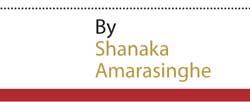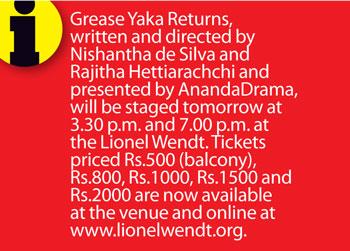Reply To:
Name - Reply Comment

 If art imitates life, then Grease Yaka’s creators are not only observant and clever, but also prescient. The tragedy it foretells (and foretold) suffered Cassandra’s curse, as bedlam and hysteria spiralled out of control in the wake of the Easter attacks and subsequent political machinations. If Grease Yaka was a piece of theatre that was important prior to the attacks, it has now become not only important, but vital.
If art imitates life, then Grease Yaka’s creators are not only observant and clever, but also prescient. The tragedy it foretells (and foretold) suffered Cassandra’s curse, as bedlam and hysteria spiralled out of control in the wake of the Easter attacks and subsequent political machinations. If Grease Yaka was a piece of theatre that was important prior to the attacks, it has now become not only important, but vital.
The Grease Yaka has already seen a few avatars; both in the form of a political fear-mongering device and in the form of a dramatic enterprise, undertaken by the topical and incisive team at AnandaDrama. Its latest manifestation attempts to take on one of the most conditioned and unnatural forms of social division, and through it, examine the futility of ‘othering,’ of tribalism and violent consequences that inevitably follow. Its takeaway cannot be more relevant than at this particular juncture of history.
For a country that in a very short time has seen two leftist insurrections – infamous for their gruesome brutality – and also a three-decade-long conflict which pioneered devastating suicide bombing techniques, Sri Lanka certainly doesn’t learn its lessons very quickly. The most recent evidence of our abysmal studentship of history was reflected in the swathe of Islamophobia that swept the island in the aftermath of the horrors of Easter Sunday. While some theatregoers may not have contributed by throwing petrol bombs in Minuwangoda, many of us may have contributed by forwarding WhatsApp messages in Moratuwa, or posting inflammatory messages in Maharagama. Adding to July ’83 and JVP ’71 and ’89 were the unacceptable events on May 13.
Grease Yaka Returns examines the growing commercial investment into division
All these conflicts were fought between tribes; tribes that had more in  common genetically and culturally, than they had differences. ‘Grease Yaka Returns’ is a study in how those commonalities are deliberately ignored, how old ties are severed for perceived new profits and differences energised. It is a study on how susceptible and volatile we are as a society. Conceptually, this is not a complex, abstract study, as the evidence of our volatility is dispensed to us on a daily basis, in schools on the playing fields, in workplaces, on social media, and – lest we forget – in Parliament. Grease Yaka Returns drives it home without apology.
common genetically and culturally, than they had differences. ‘Grease Yaka Returns’ is a study in how those commonalities are deliberately ignored, how old ties are severed for perceived new profits and differences energised. It is a study on how susceptible and volatile we are as a society. Conceptually, this is not a complex, abstract study, as the evidence of our volatility is dispensed to us on a daily basis, in schools on the playing fields, in workplaces, on social media, and – lest we forget – in Parliament. Grease Yaka Returns drives it home without apology.
The original version of Grease Yaka, presented by AnandaDrama and directed by Ruwanthie de Chickera in 2014, was ‘inspired’ by the actual social phenomenon which broke out a couple of years ago. Grease Yaka, like the Goni Billa before it, are harbingers of a time of war, of uncertainty, and above everything else – fear. The play examined the political manoeuvres that most likely were behind the media sensation, and how political sociopaths engineer these distractions for gain. The original version showed how effectively the sheep-like populace reacted to the media frenzy. In that regard, the latest version stays true to its original format. Its graduation however, from being a purely narrative piece portraying a slice of recent history, to an introspective device which intrinsic fear of the ‘other’ needs to be commended.
Grease Yaka Returns, written and directed by Nishantha de Silva and Rajitha Hettiarachchi, begins with a casual enough scene of two siblings, and the sister’s boyfriend, looking out at the friendly neighbourhood pervert. It doesn’t take long for banter to turn into undercurrents of fear. “Is our creepy neighbour the Grease Yaka?” The script assumes that the urban legend of Grease Yaka is already ubiquitous.
Grease Yaka Returns takes us back to a time when warring factions, barely distinguishable from each other visit each other’s homes and hideouts to mete out reprisals, based on the colour of the target’s skin
The play continues with various settings – an office lunchroom, a shoe shopping expedition, a bus stand – beginning in similarly innocent fashion. Slowly, insidiously, the terror begins to build. The fear is heightened, and eventually all hell breaks loose. This time, the differentiating device between the antagonists was not caste, creed, race or religion – as it was in the previous version, and often is, in real life. It was something far more accidental and far less constructed. It was complexion.
It is necessary to draw a distinction between skin colour and complexion. Skin colour, in communities that are genetically diverse, can be a clear demarcation of race, and thereby, difference. However, in communities that are not as genetically diverse, communities that are geographically less disparate, skin colour per se, is not a differentiating feature. Sri Lankans abroad will recognise other Sri Lankans abroad, it doesn’t matter if they are ‘fair’ or ‘dark’ – they just have a lingering Sri Lankan-ness. However, Grease Yaka Returns deftly manages to create a divide even within this seemingly-homogenous population.
The play functions on the premise that the fear of Grease Yaka has already been sown, if not fully-germinated. At the start of the play it is an abstract, amorphous, fear; nothing specific; the fear of the unknown. Slowly, the unknown starts being identified, and labelled. It turns out to be a ‘fair’ vs. ‘dark’ divide. A division as visceral as it is ridiculous. A division that is subjective by its indefinability. And for those very reasons, the division that makes most sense to the play’s goal.
As a Sri Lankan society, we cannot pretend to be oblivious to the aspiration of ‘fairness.’ Failed chocolate biscuit advertisements and skin whitening cream sales bear testament to our obsession with fairness. While this obsession does exist in society, it has remained largely an individual one. One where jilted lovers may stare into the mirror and blame their skin or desperate parents will bemoan their combined genes for the inability to marry off their son or daughter. A quick search of the classified matrimonials will reveal ‘fair’ is one of the leading adjectives to describe both genders of potential spouse. However, chances are that hopeful parents realise – or don’t – that their hitherto unmarried 90kg daughter is as ‘slim’ as the neighbour’s ‘fair’ son has the complexion of barbecue coals. The sliding scale of fairness lends itself to the hilarity of the division, and once the hilarity has subsided, reminds us of the chilling pathos of manufacturing divisions where there are none.
Grease Yaka Returns is clever. It takes hang ups such as class divides, linguistic proficiency and wealth, and turns them on their heads. The ‘fair’ peon eventually turns the tables on his darker boss, as the office lunchroom divides into – for lack of a better denominator – the blacks and whites. The classist snob, who looks down his tanned nose at the girl buying the cheap shoes as his ‘fair, pretty’ wife (possibly located off the matrimonials), eventually has to run for cover as his riches and snobbery cannot save him from the wrath of lighter complexioned plebs. The rise and fall of the individual characters in what is an ensemble piece is handled effectively and with care. The cues are subtle and the ability of the actors to move between roles and scenes is exceptional. For this genre, a little bit of ham is entirely excusable.
The role of the media is excellently condemned in the play, almost prophetically, as recent events have proved. The most elaborate scene is one where the entire cast watches snippets of popular culture on television. The vacant look of the viewers, and their reactions to what they see on screen needed a little more clarity, but the scene was well devised. Perhaps, a few tweaks in the staging will better illustrate how dependent on, and reactive we are, to what we are told by the media. The collective reactions to the ever-growing paranoia in the programmes being enacted could perhaps have been more precise, though the idea was excellent. No doubt, the most recent version of this fluidly transforming play will be to include a news anchor as the chief wreaker of havoc in this scene.
In its short duration of just over an hour, Grease Yaka Returns also managed to examine the growing commercial investment into division. The current reaction to the Muslim community that is perceived as being ‘successful in business’ has made this facet of the play suggest that its creators may have had access to a crystal ball. The fears of a mother grieving for her daughter’s complexion to be changed, and the mercenary quack who ‘treats’ her daughter for her dark complexion with cream and injections are caricatures. But in a Sri Lankan society where the line between comedy and reality is ever-blurring, the caricatures are all too familiar. The commercial exploitation of fear and conflict was laid bare, together with the disastrous consequences of such commercialisation. The play leaves us with a mother injecting her trussed up – previously carefree and happy – daughter with medicine against her complexion, in the hope she would turn white. Whether the daughter survives this remedy remains tragically ambiguous.
The scenes of actual conflict are well choreographed. It has not been long since the JVP troubles of the late ’80s and even less long since the helmeted, kerchiefed mobs of two months ago. Grease Yaka Returns takes us back to a time when warring factions, barely distinguishable from each other visit each other’s homes and hideouts to mete out reprisals, based on the colour of the target’s skin. While the narrative device remains ridiculous, the playing out of the scenes, is chillingly-familiar to some of us, while – happily – a generation of under thirty-year-olds may not find the chaos and anarchy as ‘nostalgic.’ Unsuspecting innocents being dragged out of their homes and executed is uncomfortable to watch even if it were only on stage. This discomfort was proportionately dealt to the audience amid the scenes of outright comedy.
There are two definitive sides, and, as always, politicians patronise the two factions, crystallising and exploiting previous fears into a ‘movement.’ Misguided, trigger-happy youth are mustered, assured of intangible ‘support,’ and sent to the trenches while the fat cats spew rhetoric and enjoy the good life. The use of some actual political speeches from the early ’80s is a nice touch by the directors, and plainly shows how Sri Lanka is still stuck in a deeply divisive time warp, the fuse ever so close to being set off.
As the concept of the play moved deftly over time, from race-related animosity, to the less obvious, but more pervasive issue of complexion, the directors have very deliberately chosen the actors with – again, for want of a better word – more ‘ambivalent’ skin tone to play the central roles. Some actors who fall into definitive roles have been cast as such. However, others remain impossible to label, despite fighting for one side or the other. Some scenes have a dark complexioned prisoner being dragged away by visibly darker skinned insurgents. The chaos and confusion is as deliberate as it could be real. Often the audience is unable to make a clear distinction between the sides during the ‘battle scenes’ and that sounds strikingly familiar.
Grease Yaka Returns is a play that is necessary; incredibly necessary. Indispensable in fact, to those who will write the narrative of the future.
Necessary to examine our nature as a country and our willingness to go down the rabbit holes of the past. It is also a play that pragmatically portrays the various actors across social strata who drive, manipulate and profit from fear-mongering. It also effectively exposes the general public as the gullible, reactive, fools they often can be gathering to create an avalanche of chaos. Grease Yaka Returns is genuinely satirical and keeps to the tenets that satire should. As a bilingual play, it needs to travel widely across Sri Lanka, and is an important piece of theatre which should not be missed for its educational as well as entertainment value. Even the most oblivious, uninformed audience member will identify with, and introspect on, at least one of its many subtle layers.